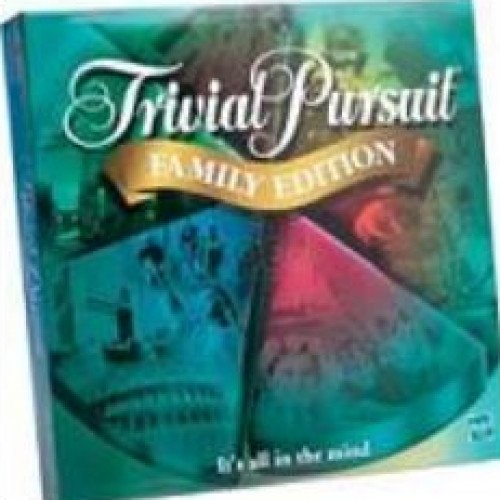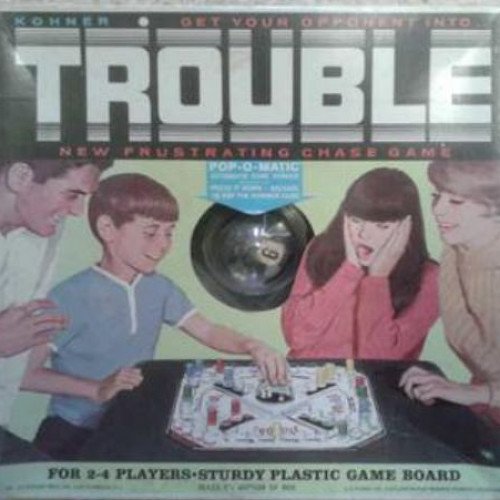"TRIVIAL PURSUIT" vs "TROUBLE"

TRIVIAL PURSUIT
Trivial Pursuit is a board game from Canada in which winning is determined by a player's ability to answer general knowledge and popular culture questions. Players move their pieces around a board, the squares they land on determining the subject of a question they are asked from a card (from six categories including "history" and "science and nature"). Each correct answer earns a plastic wedge which is slotted into the answerer's playing piece. Since the game's first release in 1981, dozens of themed editions have been released. Some question sets have been designed for younger players, and others for a specific time period or as promotional tie-ins (such as Star Wars, Saturday Night Live, and The Lord of the Rings movies). The game was created on December 15, 1979, in Montreal by Canadian Chris Haney, a photo editor for Montreal's The Gazette, and Scott Abbott, a sports editor for The Canadian Press. After finding pieces of their Scrabble game missing, they decided to create their own game. With the help of John Haney and Ed Werner, they completed development of the game, which was released in 1981. The rights to the game were initially licensed to Selchow and Righter in 1982, then to Parker Brothers (now part of Hasbro) in 1988, after initially being turned down by the Virgin Group; in 2008 Hasbro bought the full rights, for US$80 million. As of 2014, more than 100 million games had been sold in 26 countries and 17 languages. Northern Plastics of Elroy, Wisconsin produced 30,000,000 games between 1983 and 1985. In December 1993, Trivial Pursuit was named to the "Games Hall of Fame" by Games magazine. An online version of Trivial Pursuit was launched in September 2003.
Statistics for this Xoptio

TROUBLE
Trouble (known as Frustration in the UK and Kimble in Finland) is a board game in which players compete to be the first to send four pieces all the way around a board. Pieces are moved according to the roll of a die. Trouble was developed by the Kohner Brothers and initially manufactured by Irwin Toy Ltd., later by Milton Bradley (now part of Hasbro). The game was launched in America in 1965. The classic version is now marketed by Winning Moves Games USA. The gameplay, board, and concept is derivative of the Indian board game, Ludo. A similar game called Headache was also produced by the Milton Bradley Company; besides a different track layout, its pawns are conical, compared to the cylindrical pieces used in Trouble. Players can send opponents' pieces back to the start by landing on them. Players may not touch the other player's piece, otherwise the piece's owner must redo the pop/roll. Teaming is not allowed in the game. Pieces are protected from capture after arriving in the final four slots. Unlike more complex race games, however, counters cannot be maneuvered to block opponents' moves. The most notable feature of Trouble is the "Pop-O-Matic" die container. This device is a clear plastic hemisphere containing the die, placed over a flexible sheet. Players roll the die by pressing down quickly on the bubble, which flexes the sheet and causes the die to tumble upon its rebound. The Pop-O-Matic container produces a popping sound when it is used, and prevents the die from being lost (and players from cheating by improper rolling). It allows for quick die rolls, and players' turns can be performed in rapid succession. The die is imprinted with Arabic numerals rather than the traditional circular pips (though the circular pips are used in the Travel version, which contains a cover to keep the pegs from being lost). Players may move pieces out of their start only when the die lands on 6. Getting a 6 at any point in the game also allows the player to take another turn, even if the player cannot move any of their pieces (as they cannot land on any of their own pieces). They can also move a new piece out even if they have another piece currently in play, and can also do the same if another player's piece is occupying their "start" space, but cannot do so when one of their own pieces is occupying their "start" space. File:Pop-o-matic video.ogv Demonstration of the Pop-O-Matic bubble from Headache If the die in the "Pop-O-Matic" container has not clearly landed on a number, then the player who popped it can tap the "Pop-O-Matic", but may not re-pop while the die is in limbo.